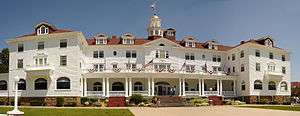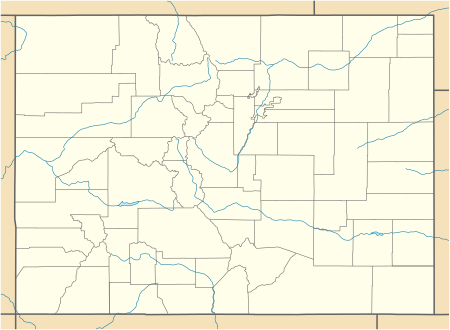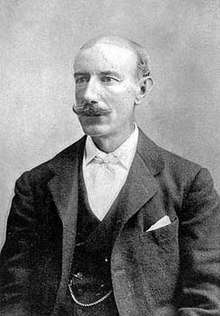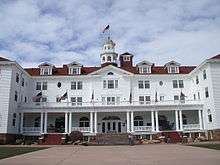The Stanley Hotel
|
The Stanley Hotel | |
 | |
 | |
| Location | 333 Wonderview Avenue, Estes Park, Colorado |
|---|---|
| Coordinates | 40°23′0″N 105°31′6″W / 40.38333°N 105.51833°WCoordinates: 40°23′0″N 105°31′6″W / 40.38333°N 105.51833°W |
| Architect | Freelan Oscar Stanley, T. Robert Weiger, Henry Rogers |
| Architectural style | Colonial Revival |
| NRHP reference # | 85001256[1] |
| Added to NRHP | May 26, 1977 (expanded June 20, 1985 and April 16, 1998) |
The Stanley Hotel is a 142-room Colonial Revival hotel in Estes Park, Colorado, United States of America. Approximately five miles from the entrance to Rocky Mountain National Park, the Stanley offers panoramic views of Lake Estes, the Rockies and especially Long's Peak. It was built by Freelan Oscar Stanley of Stanley Steamer fame and opened on July 4, 1909, catering to the American upper class at the turn of the century.[2] The hotel and its surrounding structures are listed on the National Register of Historic Places.[1]
The Stanley Hotel hosted the horror novelist Stephen King, serving as inspiration for the Overlook Hotel in his 1977 bestseller The Shining and its 1980 film adaption of the same name, as well as the location for the 1997 miniseries. Today, it includes a restaurant, spa, and bed-and-breakfast, and provides guided tours which feature the history and alleged paranormal activity of the site.
History
In 1903, the Yankee steam-powered car inventor Freelan Oscar Stanley (1849-1940) was stricken with a life-threatening resurgence of tuberculosis.[3] The most highly recommended treatment of the day was fresh, dry air with lots of sunlight and a hearty diet. Therefore, like many "lungers" of his day, Stanley resolved to take the curative air of Rocky Mountain Colorado. He and Flora arrived in Denver in March and, in June, decided to spend the rest of the summer in the mountains, in Estes Park. Over the course of the season, Stanley's health improved dramatically.[2] Impressed by the beauty of the valley and grateful for his recovery, he decided to return every year. He lived to the ripe age of 91, dying of a heart attack in Newton, Massachusetts, one year after his wife, in 1940.
By 1907, Stanley had recovered completely. However, not content with the rustic accommodations, lazy pastimes and relaxed social scene of their new summer home, Stanley resolved to turn Estes Park into a resort town. In 1907, construction began on the Hotel Stanley, a 48-room grand hotel that catered to the class of wealthy urbanites who composed the Stanleys' social circle back east.[3]

The land was officially purchased in 1908 through the representatives of Lord Dunraven, the Anglo-Irish peer who had originally acquired it by stretching the provisions of the Homestead Act and pre-emption rights. Between 1872 and 1884, Dunraven claimed 15,000 acres (61 km2) of the Estes Valley in an unsuccessful attempt to create a private hunting preserve, making him one of the largest foreign holders of American lands. Unpopular with the local ranchers and farmers, Dunraven left the area for the last time in 1884 relegating the ranch to the management of an overseer.[2][3] Dunraven's presence in Colorado had become so well known in the United States that his situation was parodied in Charles King's novel Dunraven Ranch (1892) as well as James A. Michener's Centennial (1974). His reputation was such that, when Stanley suggested "The Dunraven" as a name for his new hotel, 180 people signed a buckskin petition requesting that he name it for himself instead.
The structure was completed in 1909 and featured a hydraulic elevator, dual electric and gas lighting, running water, a telephone in every guest room and a fleet of specially-designed Stanley "Model Z" Mountain Wagons to bring guests from the train depot twenty miles away; all of this at a time when Estes Park was little more than a locale for hunters and naturalists. Originally, Stanley chose an ocher color for the hotel's exterior with white accents and trim. The hotel was not equipped with heat until 1983 and closed for the winter every year. The presence of the hotel and Stanley's own involvement greatly contributed to the growth of Estes Park (incorporated in 1917) and the creation of the Rocky Mountain National Park (established in 1915).
Stanley operated the hotel almost as a pastime remarking once that he spent more money than he made each summer. In 1926, he sold the Stanley to a private company incorporated for the sole purpose of running it. The venture failed and, in 1929, Stanley purchased his property out of foreclosure selling it again, in 1930, to fellow auto and hotel magnate Roe Emery of Denver. During Emery's tenure as owner, the structures were painted white inside and out and most of the original electro-gas fixtures were replaced.
Gallery
- June 2008
- February 2011
 South elevation
South elevation Lobby looking east
Lobby looking east- Music room looking south
Architecture
The Stanley Hotel National Register Historic District contains eleven contributing buildings including the main hotel, a concert hall, carriage house and The Lodge, a smaller bed-and-breakfast originally called Stanley Manor. The buildings were designed by F.O. Stanley with the professional assistance of Denver architect T. Robert Wieger, Henry "Lord Cornwallis" Rogers, and contractor Frank Kirchoff. The site was chosen for its vantage overlooking the Estes valley and Long's Peak within the National Park. The main building is a steel-frame structure with wood cladding resting upon a granite masonry foundation. Wood for flooring, clapboarding and finishing was brought from Kirchoff's Denver Lumberyard and the Bluff City Lumber Company of Pine Bluff, Arkansas. The Griffith sawmill near Bierstadt Lake and Stanley's own Hidden Valley lumber operation, located in the future national park, supplied framing material. The materials were brought to Lyons, Colorado by rail and thence to Estes Park by mule-drawn wagon. Simultaneously, Stanley oversaw the construction of a hydroelectric power plant which brought electricity to Estes Park for the first time in 1909. Stanley claimed that his hotel was the first to be powered entirely by electricity from the lighting to the kitchens. Water was supplied by the Black Canyon Creek which was dammed in 1906.
The style of the campus is so-called Colonial Revival. Although rare in the western United States, F.O. Stanley chose the Colonial Revival for its fashionable popularity in New England where he had already designed his own home and a social club in the style. The hotel's clientele would presumably, like the Stanleys, have identified the style with New England respectability and sophistication in contrast to the rusticity of the surrounding town. At one time, Stanley planned to build another, more economical hotel in Estes Park as well as a headquarters and residence for the superintendent of the Rocky Mountain National Park in the same style, to harmonize with his grand hotel. While the forms and layouts of the buildings are suited to their modern uses, their ornamentation exhibits the stylistic hallmarks of Georgian or Federal architecture from the staunch symmetry of the south elevation to the cupola, dormers, Palladian windows, side- and fan-lights, scroll brackets and "swan's neck" pediments that articulate the exterior.
Main Building
The floor plan of the main hotel building was laid out to accommodate the various activities popular with the American upper class at the turn of the twentieth century and the spaces are decorated accordingly. The music room, for instance, with its cream-colored walls (originally green and white), large windows and fine, classical plaster-work was designed for letter-writing during the day and chamber music at night - cultured pursuits perceived as feminine. On the other hand, the smoking lounge (today the Piñon Room) and adjoining billiard room, with their dark stained-wood elements and granite fireplace were designated for enjoyment by male guests. Stanley himself, having been raised in a Protestant household in the tee-totaling State of Maine and having recovered from a serious lung disease, did not smoke cigars or drink alcohol, but these were essential after-dinner activities for most men at the time. Billiards, however, was among Stanley's most cherished pastimes.
The layout was also determined by air circulation. The window at the top of the grand stair provides a pleasant breeze across the lobby, French doors in the state rooms open onto shaded verandas and the two curving staircases connecting the guest corridors prevent stagnant air in the upper floors. Although the hotel was finally updated with central heating in 1983, guests still depend on Rocky Mountain breezes for cooling in the summer. Also completed in 1983, the hotel's service tunnel connects the basement level to the staff entrance. It is cut directly through the granite on which the hotel sits.
Concert Hall
The concert hall, east of the hotel, was built by Stanley in 1909 with the assistance of Henry "Lord Cornwallis" Rogers, the same architect who designed his summer cottage. According to popular legend, it was built as a gift for Flora Stanley who was an avid pianist despite her failing eyesight. The interior is decorated in the same manner as the smaller music room and somewhat resembles that of the Boston Symphony Hall (McKim, Mead & White, 1900) with which the Stanleys may have been familiar. The stage features a trap door, used for theatrical entrances and exits. The lower level once housed a bowling alley. This feature has long since disappeared but it possibly resembled the one at the Stanley's Hunnewell Club in Newton, pictures of which are archived in the Newton Free Library. The hall underwent extensive repair and renovation in the 2000s.
The Lodge

Once called Stanley Manor, this smaller hotel between the main structure and the concert hall is a 2:3 scaled-down version of the main hotel. Unlike its model, the manor was fully heated from completion in 1910 which may indicate that Stanley planned to use it as a winter resort when the main building was closed for the season. However, unlike many other Colorado mountain towns now famous for their winter sports, Estes Park never attracted off-season visitors in Stanley's day and the manor remained empty for much of the year. Today it is called The Lodge and serves as a bed-and-breakfast off-limits to the public.
The Hedge Maze
In 2015, the open area in front of the hotel, originally a driveway for Stanley Steamers and a promenade for guests to enjoy mountain views, was replaced with a hedge maze. This non-historic feature was added to evoke the hotel's connection to The Shining. Although a hedge maze features prominently in Stanley Kubrick's version of The Shining, no such feature can be found in Stephen King's novel. The lawn of the Overlook Hotel, as King imagined it, was adorned with topiary animals and it was set that way for the shooting of the miniseries in 1996. Historically, neither feature existed at the Stanley. The design was the result of a competition, chosen from amongst 300 entrants from across the globe. The winning submission was designed by New York architect Mairim Dallaryan Standing.[4]
In 2016, John Cullen, owner of the Stanley Hotel, announced a competition for a sculpture to be the centerpiece of the terrace in front of the hotel. Sculptors Sutton Betti and Daniel Glanz won the competition with a sculpture of F.O. Stanley holding one of his violins. The sculpture was installed and dedicated on September 29, 2016. Another hotel was used for filming the outside shots, and the Stanley for inside shots.
The Shining
On October 30, 1974, horror writer Stephen King and his wife Tabitha spent one night at the Stanley Hotel during their one year of residency in Boulder, Colorado.[5] They were driving through Estes Park as night approached when they happened upon the Stanley Hotel. They decided to book a room and, upon checking in, discovered that they were the only overnight guests. "They were just getting ready to close for the season, and we found ourselves the only guests in the place — with all those long, empty corridors."[6][7] He and his wife were served dinner in an empty dining room accompanied by canned orchestral music. "Except for our table all the chairs were up on the tables. So the music is echoing down the hall, and, I mean, it was like God had put me there to hear that and see those things."[8] That night, according to King, "I dreamed of my three-year-old son running through the corridors, looking back over his shoulder, eyes wide, screaming. He was being chased by a fire-hose. I woke up with a tremendous jerk, sweating all over, within an inch of falling out of bed. I got up, lit a cigarette, sat in a chair looking out the window at the Rockies, and by the time the cigarette was done, I had the bones of The Shining firmly set in my mind."[9] “Any big hotels have got scandals," King wrote in The Shining. "Just like every big hotel has got a ghost. Why? Hell, people come and go. Sometimes one of ‘em will pop off in his room, heart attack or stroke or something like that. Hotels are superstitious places.”[10]
The Shining was published in 1977 and became the third great success of King's career after Carrie and 'Salem's Lot. The Overlook Hotel - the fictional hotel in King's book inspired by the Stanley - is an evil entity haunted by its many victims. Room 217 of the Overlook features prominently in the novel, having been the room where King spent the night at the Stanley. This is the room on the second floor in the center of the west wing with a balcony overlooking the south terrace. Room 217 remains the hotel's most requested accommodation.
Film location and arts venue
In 1980, The Shining became the basis for a film adaptation directed by Stanley Kubrick. Kubrick's vision for the movie differed from King's significantly in many ways, including the portrayal of the Overlook Hotel. The exteriors of Kubrick's Overlook were supplied by the Timberline Lodge on the slopes of Mt. Hood in Oregon. Inspiration for the interior sets (erected at Elstree Studios in England) came from the 1927 Ahwahnee Hotel in Yosemite National Park. The management of the Timberline Lodge, fearful that guests would refuse to stay in their Room 217 if it were featured in a horror movie, insisted that Kubrick change the haunted room in the film to Room 237.
In 1997 The Shining TV series was produced, with the Stanley Hotel as the primary shooting location. A playhouse version of the main building which adorned the lawn of the Overlook Hotel in the series can be viewed in the basement of the Stanley.
The Hotel has also been used as a filming location for other movies and TV shows; most notably, as the fictional "Hotel Danbury" of Aspen, Colorado, in the 1994 film Dumb and Dumber.[11]
From 2013 to 2015, the hotel property hosted the Stanley Film Festival, an independent horror film festival operated by the Denver Film Society, held in early May. The festival featured screenings, panels, student competitions, audience awards and receptions.[12] The Stanley Film Festival was put on hiatus in 2016, and canceled for 2017.[13]
The historic Stanley Concert Hall serves as venue for various musical groups such as country-punk band Murder By Death which has performed a Shining-themed series of concerts in the space.
Bravo's cooking competition, Top Chef, also used the Stanley as a venue for Episode 10 of Season 15, all of which took place in various locations in Colorado.
Haunted reputation
Despite a peaceful early history, in the years following the publication of The Shining, The Stanley Hotel has gained a reputation among paranormal investigators for frequent activity.[14][15][16] The hotel offers guided "Ghost Tours" to guests and visitors which feature spaces reputed to be exceptionally active.[17][18] The hotel has also served as a location for numerous paranormal investigation shows such as Ghost Hunters[19][20] and Ghost Adventures.[21]
Famous guests
The Stanley Hotel has hosted the following persons of note:
- 1934 - Erich Fromm, the German psychoanalyst[22]
- 1936 - Gov. Alf Landon (R, Kansas): opponent to Franklin Delano Roosevelt’s re-election[23][24]
- 1974 - Stephen King, author who was inspired to write The Shining from his stay in room 217[5]
- 1976 - Bob Dylan & Joan Baez, classic rock icons during the Rolling Thunder Revue tour[25]
- 1994 - HM Emperor Akihito of Japan, Empress Michiko and Crown Prince Naruhito, on a state visit to the US[26]
- 1994 - Dumb and Dumber cast and crew including Jim Carrey and Jeff Daniels for the “Danbury Hotel” location[27]
- 1996 - The Shining (miniseries) cast and crew including Rebecca De Mornay and Steven Weber[28]
Ownership history
- 1908–26 - Freelan Oscar Stanley
- 1926–29 - The Stanley Corporation
- 1929–30 - Freelan Oscar Stanley[29]
- 1930–1946 - Roe Emery[29]
- 1946–1966 - Abbell Management Company (later Abbell Hotel Company), run by Maxwell Abbell, Chicago real estate investor[29][30]
- ?–1969 - Stanley Properties, Inc., headed by Maurice L. Albertson, civil engineer at CSU[31]
- 1969–? - Richard R. Holechek, Charles F. Hanson and Carol Hanson Pick of Riverside and Palm Springs, California[31]
- 1995–present - Grand Heritage Hotel Group
See also
References
- 1 2 National Park Service (2008-04-15). "National Register Information System". National Register of Historic Places. National Park Service.
- 1 2 3 "Rocky Mountain Legends". LegendsOfAmerica.com. Missing or empty
|url=(help);|access-date=requires|url=(help) - 1 2 3 "Rocky Mountain National Park - Culture". US-Parks.com. Retrieved 2007-05-10.
- ↑ Turkewitz, Julie (3 September 2015). "Hotel That Inspired 'The Shining' Builds on Its Eerie Appeal". New York Times. Retrieved 17 September 2015.
- 1 2 Beahm, George (September 1998). Stephen King from A to Z: An Encyclopedia of His Life and Work. Andrews McMeel Publishing. ISBN 9780836269147.
- ↑ "The Stephen King Companion" Beahm, George Andrews McMeel press 1989
- ↑ "Stephen King Country" Beahm, George Running Press 1999
- ↑ Vvdailypress.com Archived October 18, 2006, at the Wayback Machine.
- ↑ "Stephen King: America's Best Loved Boogeyman" Beahm, George Andrews McMeel Press 1998
- ↑ "The Steamer, "The Shining," and the Stanley Hotel". The Attic. Retrieved 25 July 2018.
- ↑ "Stanley Hotel Ghost Story". Allstays.com. Retrieved 2007-05-09.
- ↑ McHargue, Brad. "Inaugural Stanley Film Festival to Showcase Independent Horror Cinema May 2–5 at the Stanley Hotel". Mile High Cinema. Archived from the original on 23 March 2014. Retrieved 19 February 2013.
- ↑ Walker, Chris (15 November 2016). "Stanley Hotel Cancels 2017 Horror Film Fest; Film Center Director Resigns". Westword. Retrieved 27 March 2017.
- ↑ "Haunted Hotel History". www.stanleyhotel.com.
- ↑ "Stanley Ghost Stories Shine with Authenticity". www.stanleyhotel.com.
- ↑ McCarthy, Sky (14 April 2016). "Stanley Hotel guest captures creepy figure in lobby". Fox News.
- ↑ "Hotel Tours | Estes Park Colorado Tours | The Stanley Hotel". www.stanleyhotel.com.
- ↑ "UPDATED: Haunted Stanley Hotel Suspends Ghost Hunts".
- ↑ "The Stanley Hotel: Season 2, Episode 22". Syfy.
- ↑ "Best of the Stanley Hotel: Season 3, Episode 5". Syfy.
- ↑ "Stanley Hotel - Ghost Adventures - TravelChannel.com". Travel Channel.
- ↑ Funk, Rainer (2000). Erich Fromm: His Life and Ideas, an Illustrated Biography. A&C Black. p. 82. ISBN 9780826415196. Retrieved 14 October 2017.
- ↑ Mitchell, Steve (2016). Legendary Locals of Estes Park. Arcadia Publishing. ISBN 9781439655955. Retrieved 14 October 2017.
- ↑ "Headquarters at Estes Park for Alf Landon". Newspapers.com. Greeley Daily Tribune from Greeley, Colorado. June 24, 1936. Retrieved 14 October 2017.
- ↑ Johnson, Tracy (2000). Encounters with Bob Dylan: If You See Him, Say Hello. humble Press. ISBN 9780964700925. Retrieved 14 October 2017.
- ↑ "(album.rmnp100.com)". album.rmnp100.com. Retrieved 14 October 2017.
- ↑ "9 Places From TV And Movies You Can Actually Visit". Huffington Post. 2014-06-23. Retrieved 2018-01-30.
- ↑ Tuckwood, Jan (September 21, 1997). "King's Room 217". tribunedigital-chicagotribune. Retrieved 2018-01-30.
- 1 2 3 yongli (2016-03-16). "Stanley Hotel". coloradoencyclopedia.org. Retrieved 2018-04-03.
- ↑ "Greeley Daily Tribune from Greeley, Colorado on July 11, 1957 · Page 11". Newspapers.com. Retrieved 2018-04-03.
- 1 2 "The Kansas City Times from Kansas City, Missouri on November 21, 1968 · Page 33". Newspapers.com. Retrieved 2018-04-03.